Nikola inaugurates first HYLA modular hydrogen refueling station in Ontario, CA


Nikola, producer of fuel cell and battery electric semi trucks, held a grand opening for the first of its HYLA refueling stations. The goal is to build a hydrogen refueling network that can be rolled out quickly, and built up over time as fuel cell trucks become more common.
There’s a big push for zero emission trucks in California right now, in response to California’s new truck regulations. That push is particularly focused on the trucking routes between the Ports of Los Angeles and Long Beach and the distribution centers of the Inland Empire – which Ontario lies at the heart of.
For a zero emission truck, you’ve got basically two choices: batteries, or hydrogen fuel cells.
Nikola sells both of these, but the problem with hydrogen is that the electrical grid is already built out, and there’s relative ease to add new chargers, whereas hydrogen fueling stations are a more involved effort.
So Nikola created its HYLA concept, which allows it to roll out temporary refueling stations in targeted areas under more simplistic permitting and construction schemes, with the potential to build these stations into a larger permanent construction later on.
As of now, the refueling station is… basically just an asphalt-and-gravel lot, with a building for 24/7 support on-site, across the street from the Ontario Airport. But it only took a few months for Nikola to set this up, which is key given the rapid rollout of electric trucks in California, especially for drayage (moving goods from port to distribution centers).

The station consists of two large liquid hydrogen tanks on trailers, each holding over 800 kilograms of hydrogen stored in liquid form. This is enough hydrogen for about 20-25 fillups. The Nikola Tre FCEV holds about 70kg of hydrogen in a tank, but fillups won’t always fill the entire tank.
Filling up takes about 20 minutes, with technicians on hand to manage the process. Fueling with highly compressed hydrogen (700 bar) is a little more complicated than uncompressed diesel or high-powered DC chargers. The equipment onboard the tank trailer also includes motors and pumps to turn the liquid hydrogen into compressed gaseous hydrogen before putting it into the Tre’s tank.
The process is also quite noisy due to the pumps onboard the trailer unit, and there is some loss of hydrogen during the pumping process – hydrogen molecules are tiny, and really hard to keep in place.
Nikola says it has been filling these tanks once every day or two so far, but wants to scale up to filling about 50-70 trucks a day, which will require daily deliveries of liquid hydrogen. Currently, that liquid hydrogen is “gray” hydrogen, which means it was produced by methane, a fossil fuel. FCEVs are still more efficient than diesel vehicles when run on hydrogen made from methane, but not as efficient as battery EVs charged from methane-generated electricity.
But just like with BEVs – it’s even better if the fuel comes from a better source. Hydrogen could theoretically be generated by electrolysis of water, powered by clean energy. This is called “green hydrogen,” and Ole Hofelmann, President of Nikola Energy, told us that Nikola would like to set up a green energy hydrogen electrolysis plant in order to produce its own liquid hydrogen and then deliver it to its own stations in its own trucks, making the whole loop have zero emissions. But that’s some ways off.
While this is only a temporary station for now, Nikola plans to make it more permanent in the future – paving the lot, building permanent pumps and so on. As that happens, the trailers can be sent to the next site, as an “advance team” to set up the site before permanent construction (and lots of permitting) begins. Nikola says it wants to have 9 stations set up in California by the end of Q2 and 14 this year – which seems ambitious. Today was the grand opening for this station, but it has been in operation for about a month and a half now.
The truck – the Nikola Tre Fuel Cell semi
The higher energy density of the hydrogen – stored at 10,000psi in four 450lb tanks behind the cab – means that the Tre FCEV has longer range (500mi) than competing electric trucks. This doesn’t matter all that much for drayage, but Nikola told us that one driver does a weekly loop filling up in Oakland, CA, driving down to Long Beach, then out to Ontario, then filling up and heading back to Oakland. This is too long a trip for most BEV trucks (except one, at least – we’ve seen the Tesla Semi do similar mileage).
We spoke with a driver, Edward from 4 Gen Logistics, who’s been driving the Tre FCEV for about 6,000 miles. He said that he he was initially intimidated by the new technology (and by the climb to get in the truck in the first place – it sits VERY HIGH), but now he likes the Tre more than other BEV trucks he’s driven like the Volvo VNR, Kenworth, and Daimler eCascadia. He says this is because the longer range means he can do 2-3 trips to the port and back in one shift, which he hasn’t been able to do with the BEV trucks. And it comes with a features to make his life easier, like automatic tire pressure and load sensing.
He also likes the performance. Similar to other electric trucks, it has a ton of torque, but Edward said the FCEV is even better at climbing hills with a full load than the BEVs he’s driven are.
I’ve driven the Daimler and Volvo myself, and both were super impressive in their drivability. I’ve ridden in the Tre FCEV tractor (with no trailer) on two occasions, and the ride is extremely quiet for a 26,200lb, 536hp tractor (about 3,000lbs lighter than the BEV – both get an extra 2,000lb weight limit, though the FCEV’s extra 2k lbs only applies in 5 states, while the BEV’s is federal). I’m also impressed with the strength of its regenerative braking – though that’s particularly hard to judge without a trailer attached.
The FCEV does have similar horsepower to the Kenworth and about 100 more horsepower than the Volvo and Daimler, but it has a much smaller battery that it’s pulling that power from. Nikola’s fuel cell stack is large, but it mainly works to charge the 164kWh onboard battery, which then goes on to power the wheels. Most hydrogen vehicles have a battery to buffer the power coming from the fuel cell stack, but this is a particularly large one, even for a semi truck.
City Dwellers’s Take
We at City Dwellers were skeptical of Nikola from early on. There are a lot of EV startups out there, and we try to cover as many of them as we can. But it’s a difficult business, and many of them are likely to fail. Everyone should always keep on guard about untested claims from new companies.
Nikola was one of those companies that made early claims that ended up not being true. As a result, its founder and former CEO, Trevor Milton, ended up in prison.
It has moved through a few CEOs since then, but seems to have largely put the Milton era behind it. Nikola is making trucks now, and has delivered far more trucks than Tesla has delivered Semis, both BEV and FCEV (though it had to recall all of its BEVs last year).
And now we’ve ridden in the FCEV twice, and it worked rather well – it ran under its own power, not just downhill like Milton’s “Nikola One”. And drivers seem to like it. That’s good progress.
As for the feasibility of fuel cells in general – many of our readers question its application and whether it’s better than BEV. We share those questions, particularly given that ~95% of hydrogen is currently produced from methane, which means it’s a lot dirtier to fill up on hydrogen than on CA grid electricity (which is generated from ~54% non-polluting sources).
California is working on adding requirements to its Low Carbon Fuel Standard (LCFS) which would require a certain percentage of “green” hydrogen to earn credits, so that might be cleaning up if progress is made on offering commercial green hydrogen credits. And if Nikola manages to build those electrolysis plants, that could solve the problem too (we also remember Tesla saying every Supercharger would have solar panels way back in 2012, and several hundred billion dollars in revenue later, that, uh, hasn’t happened).

But all of that is a long way off. However, we say similar things with EVs – even if an EV is charged with full coal power, it’s still cleaner than a gas car, and as the grid cleans up, the EV cleans up too. Same with FCEVs – if green hydrogen makes its way onto the market (or if governments finally implement carbon pricing as they should have done 100 years ago) an FCEV suddenly becomes much cleaner as well.
And if you don’t have trucks out there, then there’s no reason, or capital, for investment into building up infrastructure to generate green hydrogen. So you have to put some trucks on the road so there’s a reason to do it.
We’ve heard a lot of the same arguments from the light duty side of things – see our drive in the Honda CR-V e:FCEV earlier this week – but for those, BEV is already much more practical than FCEV. For heavy duty, especially long haul, hydrogen does have real advantages, at least in the short or medium term. So it’s good to see someone working on it – and it’s good to see Nikola working to put the specters of its past behind it.
FTC: We use income earning auto affiliate links. More.